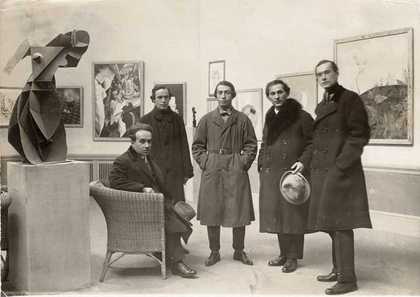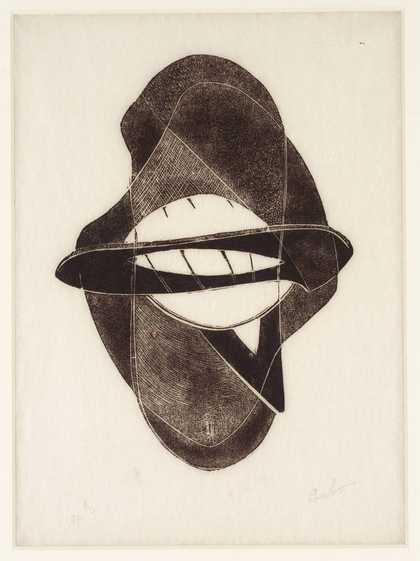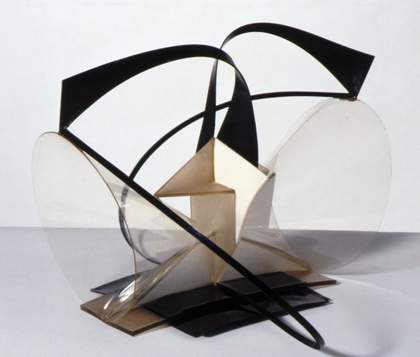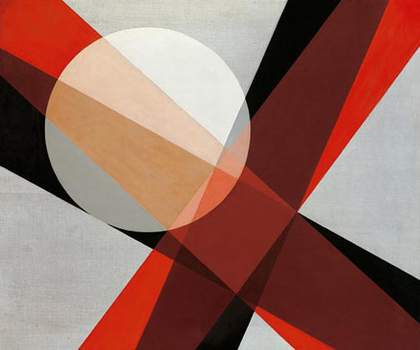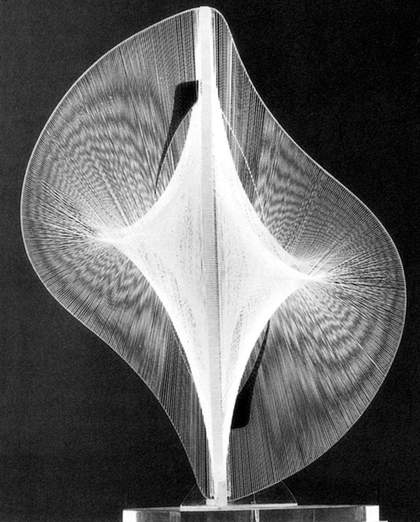
Fig.1
Naum Gabo
Linear Construction in Space No.2 (conceived 1949, this version executed 1959–60)
Perspex and nylon monofilament, height 79.5 cm
Wilhelm Lehmbruck Museum der Stadt Duisberg © Nina Williams
For Naum Gabo, the issue of making replicas, copies, and reconstructions emerged with some force during his lifetime. Like many of the sculptors working in Russia during the revolutionary period, he was sometimes forced to execute his ideas in poor-quality materials, and works frequently became lost or damaged through the upheavals of the time. His colleagues, such as Vladimir Tatlin, who remained in Russia, tended to move into design, so that early works became less central to their activities and were only rarely reconstructed (one example is when Tatlin, in 1925, made a copy of his 1915 Corner Counter Relief with rope – now in the State Russian Museum, St Petersburg).1 In contrast, Gabo went to the West and continued his career as an artist, producing work in glass, metal and rather unstable plastics, and moving fairly frequently, living in Berlin (1922–33), Paris (1933–7), London (1937–9), St Ives (1939–46); then Woodbury (1946–53); and finally Middlebury (1953–77) both in Connecticut, USA. These facts, along with Gabo’s concern with his artistic inheritance from the 1960s onwards, made the replication of his work a significant element in his creative activity. His attitudes and practice, however, are not always consistent and frequently embody contradictory impulses.
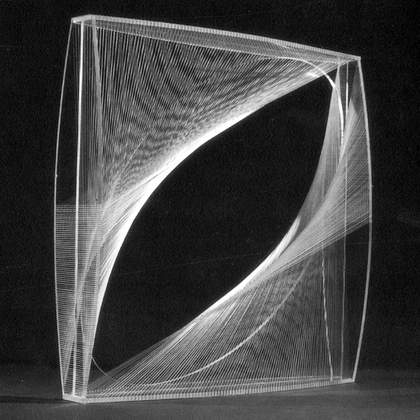
Fig.2
Naum Gabo
Linear Construction in Space No.1 (conceived 1942, this version probably executed 1960s)
Perspex with nylon monofilament, 61.3 x 61.3 x 13 cm
Art Gallery of Ontario, Toronto
In talking to his assistant, Charles Wilson, Gabo implied that it was only the sculptural idea or image that was important and that he personally did not attach any great significance to the notion of the original work of art nor the identity of the executor.2 This standpoint echoed the sentiments of the post-revolutionary Russian sculptors associated with constructivism, who embraced an industrial and collectivist ethos, which they considered appropriate to the new communist state. Some of Gabo’s sculptural practices accorded with this stance. Certainly, he employed assistants in preparing his 1930 exhibition in Germany and many of his small-scale works, particularly from the 1960s onwards, were not made by him, but by Wilson, under Gabo’s supervision.
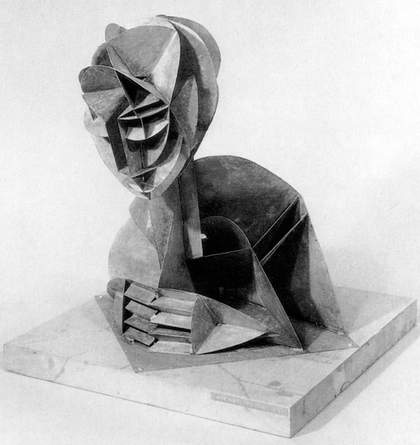
Fig.3
Naum Gabo
Constructed Head No.2 (conceived c.1916)
Galvanised iron, originally painted with yellow ochre, height 45 cm
Private collection © Nina Williams
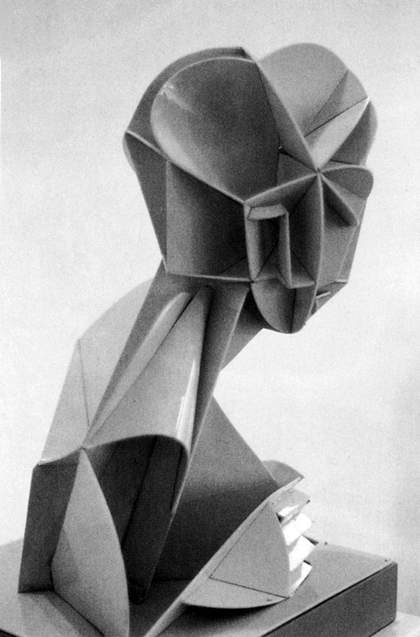
Fig.4
Naum Gabo
Constructed Head No.2 (conceived c.1916, this version probably executed c.1923)
Ivory Rhodoid, height 43 cm
Museum of Fine Arts, Dallas © Nina Williams
From the start, Gabo himself made multiple versions of particular sculptures, sometimes incorporating slight alterations. For instance, he made twenty-six versions of Linear Construction in Space No.2 (some virtually identical, others at different scales; hanging and with bases; with and without black insets)3 and seventeen of Linear Construction in Space No.1 (fig.1 and fig.2).4 Whereas all of these were made in plastic, other works were produced in a variety of media. Gabo produced several copies of a work that he considered his first masterpiece – Constructed Head No.2 (fig.3). This had originally been made in metal, but painted with yellow ochre. Gabo produced a plastic version in the mid 1920s in Germany (fig.4) and thirty years later a phosphor-bronze copy, both at the same scale as the original.5 When he reconstructed the original, which had been disassembled for decades, he stripped off the residue of paint to expose the metal material. In 1966, he and Wilson made the first of four very large, Cor-ten steel versions of Head No.2, and he exhibited one of these alongside the original metal Head in 1968.6 He also produced later metal versions of Spheric Theme, although many of the earlier versions had been in plastic (fig.5).7
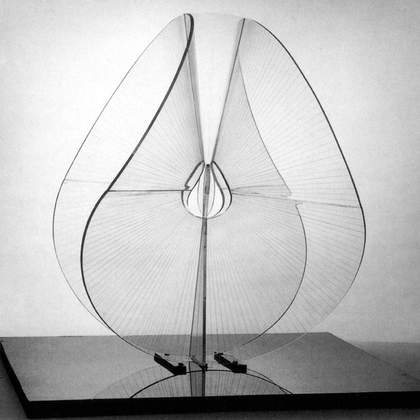
Fig.5
Naum Gabo
Spheric Theme: Translucent Variation (c.1937, this version executed 1951 as a replacement of original of 1938–9)
Perspex, diameter 57.3 cm
Solomon R. Guggenheim Museum, New York © Nina Williams
Gabo’s use of plastics made the production of replicas vital for practical as well as aesthetic reasons. Originally, the material was chosen on the basis of ideological and aesthetic precepts rather than practical considerations: Gabo believed that the artist should embrace modernity, which involved not only new ideas of space and time in sculpture, and forms redolent of advanced science and technology, but also industrial culture and its new materials, especially plastics. The availability of improved plastics (with greater clarity and flexibility) led Gabo to make exact copies or replicas of works. From the late 1930s he used Perspex (in America, Plexiglas), to make copies of works that had previously been executed in Rhodoid or other early plastics. In 1937, for instance, he remade the 1920 Square Relief (fig.6).8 He also later restored constructions such as Red Cavern c.1926, Construction in a Niche 1930, and Spheric Theme with Perspex Rods.9
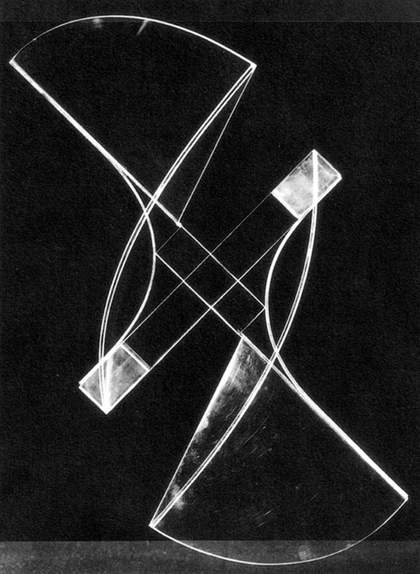
Fig.6
Naum Gabo
Square Relief lost original (c.1920, this version 1937)
Plastic on metal base, 44.5 x 44.5 x 16.5 cm
Private collection © Nina Williams
Despite any evidence to the contrary, Gabo constantly refuted the idea that the plastics from which he chose to construct his sculptures could be inherently unstable or fragile. He stated, ‘it [the work] will continue to be intact, unless deliberately broken’.10 As this statement suggests, Gabo often thought that damage was caused by negligence on the part of the owner. For instance, in 1967, when the Philadelphia Museum of Art’s Construction in Space: Two Cones (fig.7) started disintegrating, Gabo suggested it was because it was kept in an airtight case, although spectrographic analysis proved that the plastic was decaying.11 When it was returned to him for assessment, Gabo took the opportunity to make templates, from which he made an exact replica. He even used cellulose acetate, presumably to prove that the Philadelphia Museum had been in the wrong. This replica is now in the Tate; it lasted well but has deteriorated badly in the last few years.12 Yet Gabo could also be very understanding. When a member of staff at the Tate Gallery dropped the large Linear Construction No.2, which Gabo had donated in memory of Herbert Read, Gabo made a replica without a murmur of reproach.13
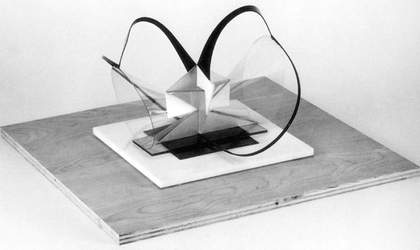
Fig.7
Naum Gabo
Construction in Space: Two Cones (conceived c.1928, this version executed 1968 as replica of 1936 original)
Cellulose acetate, 27 x 31 x 24 cm
Tate © Nina Williams
The fragility of plastic, as well as its instability, caused problems. Repairs were often required, but because of his emotional attachment to his work, Gabo sometimes considered the owner of a broken construction to be unworthy to continue in possession of the work. He told Margaret Gardiner that her Construction on a Line (fig.8) was irreparable and ‘the mere fact that you did not keep the piece in a proper way was, at that time, a sign of indifference to it on your part’.14 He kept the work for over twenty years. After his death, the sculpture was deemed irreparable and the surviving fragments were placed in the Tate Archive. In 1965, when the architect who had received a sculpture as part payment for his work on the Middlebury house twelve years before, returned the sculpture for repair, Gabo stated that nothing could be done and paid the architect the original fee. Gabo did, however, repair and resell the work. Likewise, when the Spheric Theme that Kay Sage had left to the Mattatuck Museum in Waterbury was returned for restoration, he stated that he had destroyed it, although he had, in fact, repaired it.15
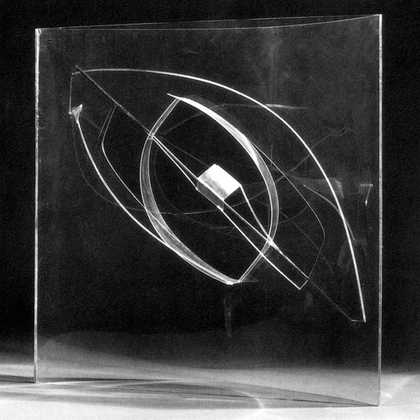
Fig.8
Naum Gabo
Construction on a Line 1937
Rhodoid and Perspex, 43.4 x 43.6 x 19.2 cm
Private collection © Nina Williams
Gabo set a high value on his time, which could be spent executing new works that he could sell, or in developing new ideas. He therefore tended to charge high prices for repairing or restoring works, which often entailed a large degree of reconstruction. In the 1950s he unsuccessfully asked Margaret Gardiner for £1,000 (the price of a new work) to repair her Construction in Space with Crystalline Centre.16 Gabo’s emphasis on money in these transactions reflected his desire to receive appropriate remuneration for his work at all times. It also reflected his experience of financial insecurity. Gabo’s family had been fairly prosperous, but lost everything with the Russian Revolution of October 1917. Gabo then experienced periods of acute poverty in emigration, especially in Paris, where at one point, in despair, he tried to commit suicide.
Gabo was clearly aware that, after completion, a replica was indistinguishable from the original work and thus came to share its aesthetic status. In his correspondence with the Philadelphia Museum of Art, over its decaying Two Cones, he indicated this, arguing that he should, therefore, be paid an appropriate sum for making it. He also stated that it cost him as much time to make a replica as make a new work that he could sell. Hence, he offered to make a replica of Two Cones for $15,000. This was less than his usual prices, but the Museum could not afford it and commissioned a copy in Plexiglas from a model-maker to keep as a record of the decayed original.17
For all the apparent impersonality of his art, it is clear that Gabo was concerned about the authorship of replicas, owing to both aesthetic and financial reasons. He certainly did not allow replicas or reconstructions by others except under exceptional circumstances. For instance, in 1968, he gave permission for Witt Wittnebert to produce a replica of Kinetic Construction (Standing Wave) for the Museum of Modern Art’s exhibition, The Machine as Seen at the End of the Mechanical Age,18 and in 1974 allowed Tate to make a working model of the work for public display.19 His willingness to allow someone other than himself or his assistants to copy this particular work may have been conditioned by the fact that he considered it to be a demonstration of kinetic possibilities in sculpture, rather than a fully developed sculpture in its own right.20
In the case of enlargements or large public works, Gabo frequently had to entrust others with the production process. In the 1960s a project for enlarging Column had floundered in part, precisely because of his desire to ensure aesthetic quality.21 In 1971, however, Gabo had enough faith in Knud Jensen, director of the Louisiana Museum, to allow him to oversee the construction of a pair of large Columns in Denmark, using Gabo’s model, his specifications, and incorporating transparent plastic bars and rings that he had made.22 Sculptures like the Bijenkorf and the St Thomas’s Fountain were also made by teams of specialists in workshops, with Gabo overseeing the process as much as possible.23
Eventually, Gabo was forced to acknowledge the instability of the early plastics and even the more fragile quality of works made in plastic as opposed to those produced in materials like metal. Considerations of durability may have also encouraged Gabo to consider welding metal works, which led him to begin working with Wilson. With Wilson’s help, Gabo started making metal versions of works previously made in plastic. In 1965, he made a metal version of Torsion, which is a larger version of the Perspex Torsion of c.1937 (both now in Tate’s collection).24 Towards the end of his life he and Wilson also collaborated on restoring several works from the 1920s, which involved reassembling complete sculptures as well as reconstructing individual components. With the encouragement of the artist’s family, Wilson continued this process after Gabo’s death.25
The visual appearance of replicas of Gabo’s works is often more successful than that of replications of sculptures by his colleagues. The reconstructions of Konstantin Medunetsky’s works (1991), based on archival photographs, differ markedly from the one surviving sculpture in which colour is a crucial component.26 Likewise, despite Martyn Chalk’s meticulous attention to detail, his reconstructions of Tatlin’s works look ‘wrong’,27 precisely because of the newness of the materials. Tatlin’s reliefs were usually made from worn materials and he intensified the varied sensations of the surfaces by working them with plaster, steam or other substances.28 In contrast, Gabo aspired to a pristine, machine-tooled finish. He deliberately used Perspex to remake earlier works such as Square Relief, not because the earlier plastic was necessarily decaying (although in some cases it was), but because Perspex emulated the marvellous transparency and translucency of glass but was far more flexible.
A posthumous replica is necessarily a reinterpretation. In Gabo’s case, the making of such objects is especially necessary because of his choice of materials, but it also represents a more natural continuation of his own working practices and aesthetic commitments than might be the case with sculpture conforming to a more ‘handcrafted’ aesthetic.

